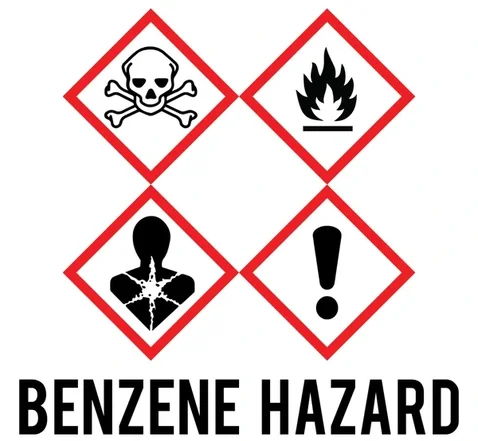An Invisible Threat to Health and the Environment
Benzene (C6H6) is an organic compound extensively used in industries, but it is also one of the most harmful pollutants having an impact on our world today. Invisible to the eye, benzene escapes into the air, water, and soil, where it creates serious risks to human health, society, and the environment. This website is commited to raising awareness about benzene's dangers, explaining its properties and sources, and encouraging our community to take steps towards safer, more sustainable choices.
Impacts

Impacts on Health
Benzene has both short-term and long-term affects. Signs and symptoms of benzene poisoning depend on how you were exposed, such as inhalation, skin contact, and eye contact.

Impacts on Society
Benzene pollution affects entire communities. Workers in industries that use benzene face higher risks, and there are economic and social costs, which can place strain on communities.

Impacts on the Environment
Benzene is harmful to air, water, and soil. Benzene in water and soil breaks down more slowly. It is slightly soluble in water and can pass through the soil into underground water. Benzene in the environment does not build up in plants or animals, but overall has major affects.
Frequently Asked Questions
Safety Issues (WHIMS) in Handling Benzene
Benzene is classified as highly hazardous under WHMIS because it is flammable, toxic, and a known human carcinogen. Its volatility means vapors can quickly build up, creating both fire hazards and risks of inhalation, while its lipid solubility allows it to pass through the skin. Safe handling requires fume hoods, proper ventilation, personal protective equipment (gloves, goggles, lab coats), and storage in sealed containers away from heat sources. Benzene's volatility is why inhalation is the most dangerous way of being exposed.
• Skull and Crossbones → Acute toxicity (harmful or fatal if inhaled/ingested in large amounts)
• Flame → Flammable liquid, vapors ignite easily
• Health Hazard → Carcinogenic, mutagenic, causes organ damage (like bone marrow suppression and leukemia)
• Exclamation Mark → Irritation to skin, eyes, and respiratory system


Catholic Perspective
From a Catholic perspective, the issue of benzene pollution reminds us of our responsibility as stewards of God’s creation. In Genesis 2:15, humanity is called to ‘till and keep’ the Earth, which means protecting the environment and caring for the health of all people. The effects of benzene on human health, particualary vulnerable groups such as children, workers, and the poor, raise serious ethical concerns. Catholic social teaching emphasizes the dignity of every person and the common good, so society has a moral duty to limit harmful pollutants and choose safer, more sustainable practices. Caring for creation by reducing pollution is not only a scientific responsibility, but also a moral and spiritual obligation to protect both current and future generations.
Contact us
Get in touch with us to learn more information
Create Your Own Website With Webador